The Long History of Mandalore to Know Before The Mandalorian Season 3

- Oops!Something went wrong.Please try again later.
- Oops!Something went wrong.Please try again later.
Star Wars canon is fascinated with the homeworld of the Mandalorians—ever since The Clone Wars radically overhauled the status quo of its people, the planet has loomed large, casting a shadow of intrigue across the works of Dave Filoni. When The Mandalorian returns March 1 for its third season, we’ll be heading back there too.
But a lot has changed since we last visited Mandalore in Star Wars Rebels, and chronologically speaking even more since Clone Wars’ final season. Then standing on the precipice of a new hope, the planet and its peoples have been torn apart by conflicts internal and external. Now, it is once more on the potential edge of reunification—but before we see just what will come of Mandalore, here’s a reminder of the generations of conflict that got us to The Mandalorian season three.
Read more
These Winning Close-Up Photos Show Life That's Often Overlooked
Remembering Enterprise: The Test Shuttle That Never Flew to Space
Rise of the Mand’alor
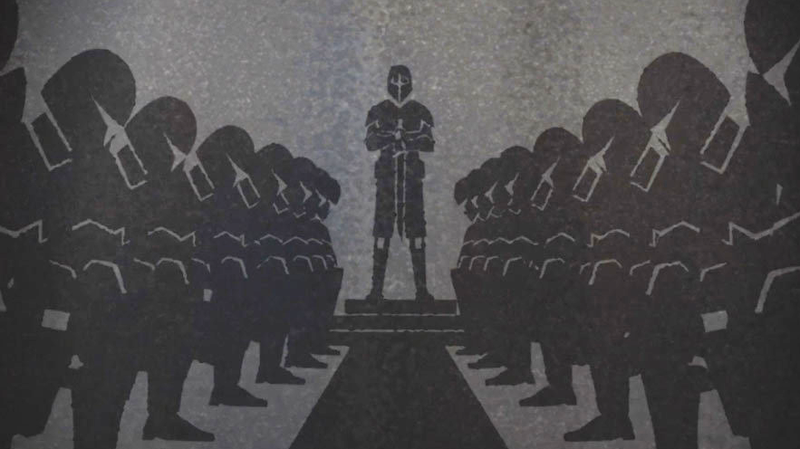
What little we know of Mandalore’s ancient history reads like much of its more recent history as well—a world of scattered clans and factions just as likely to fight each other as they were external threats. Thousands of years before the events of the Star Wars movies, however, those factions would become united under the banner of Mand’alor, a warrior worthy of leading all Mandalorians into battle. One of the first we know of is Tarre Viszla, the first Mandalorian to be inducted into the Jedi Order. Rising to knighthood, Viszla constructed his own unique lightsaber: a black-bladed sword with a hilt made out of beskar, the legendary alloy mined on Mandalore and other worlds inhabited by the clans, called the Darksaber.
Viszla would use the sword to unite the myriad clans of Mandalore to become a leader of not just his own family house, but all Mandalorian clans. But his death would bring about generations of conflict between his home and the organization that took him in.
The Crusades
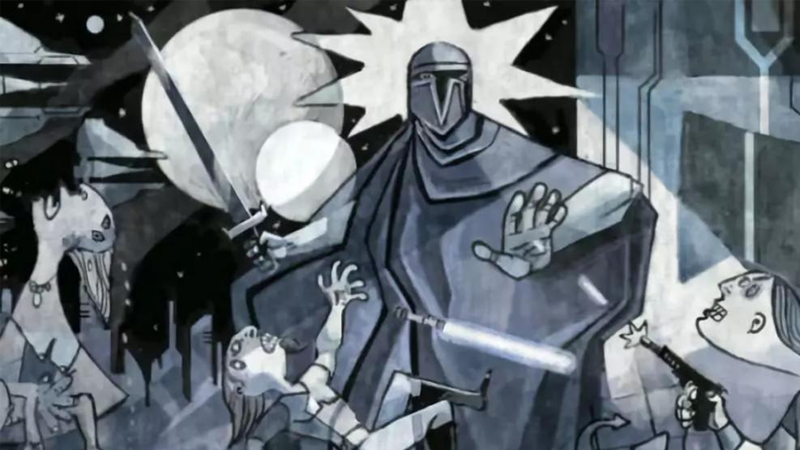
The Mandalorians entered conflict against the Jedi Order and the nascent Galactic Republic over periods of generations in Mandalore’s early history. Their battles against the Order in particular led to an arms race that saw Mandalore’s warrior culture adapt and technologically advance to combat the weapons and abilities of the Jedi. Beskar’s strength as an alloy capable of blocking the Jedi’s lightsaber blades allowed the Mandalorians to press the advantage against their sworn enemies.
Eventually, descendants of Tarre Viszla took advantage of the Jedi and Republic’s conflicts with the ancient Sith to infiltrate the Jedi Temple on Coruscant, liberating the Darksaber from its interment after Viszla’s death—reclaiming the symbol of unity that inspired their people to unite generations before them.
The First Cataclysm
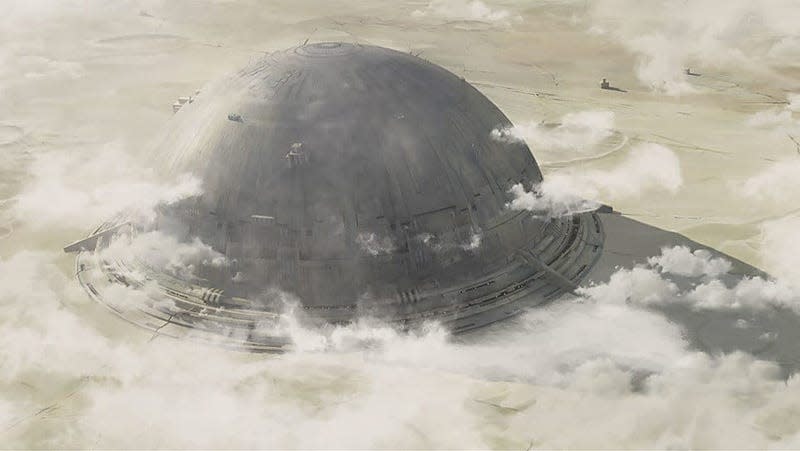
The Mandalorian-Jedi War climaxed in disaster for Mandalore. In the final battles on the world between the Jedi Order and the Mandalorians, the lush ecosystems of Mandalore were devastated, burned and transformed into a barren, largely inhospitable desert. Mandalorian society was radically changed, and what little remaining unity that had first brought the clans of their warrior culture together was shattered, driving Mandalore back to a society of isolationists.
The Mandalorian Civil War

Hundreds of years later, it is this fractured society that gives way to a new cultural divide among the Mandalorians. Horrified by the cataclysm that ended their eons of war against the Jedi, a sociopolitical group formed under the banner of the New Mandalorians, a faction that advocated for a rejection of Mandalore’s martial history and the warrior-clan structure in favor of a pacifist, isolationist parliamentary democracy.
Civil war broke out between the New Mandalorians and the Martial Traditionalists, who wished to remain loyal to Mandalore’s warrior culture, leading to another bloody period for the planet. The death toll in the civil war was enormous, almost threatening to wipe out the Mandalorians entirely, but intervention by the Galactic Republic—through the Jedi Order, and particularly Knight Qui-Gon Jinn and his apprentice, Obi-Wan Kenobi—helped the New Mandalorians by safeguarding the faction’s young leader, Duchess Satine Kryze, from assassination attempts. The New Mandalorians emerged victorious from the conflict, and once again overhauled Mandalorian society—building bio-dome-covered cities, including a new capital, Sundari, to house Kryze’s allies, while the lingering outliers that remained of her enemies were exiled to the moon of Concordia.
From Republic to Empire

Kryze’s hold on the planet was relatively brief in comparison to the eons of conflict that came before her. Although the New Mandalorians’ policy of non-intervention kept it an independent world when the Republic was plunged into a civil war of its own in the Clone Wars, galactic instability allowed Kryze’s foes to reunite and move against her. United under the leadership of Concordia’s governor Pre Vizsla, the exiled traditionalists re-emerged as a mercenary faction called Death Watch, striking out against Kryze’s rule in a series of terrorist acts.
In the final days of the Clone Wars, Death Watch was subsumed into the Shadow Collective, a criminal empire operated by former Sith apprentice Maul, with Vizsla leveraging Maul’s resources and underworld connections to outfit and fund a coup against Kryze. The coup ended in chaos for Mandalore—both Satine Kryze and Vizsla were executed when Maul betrayed Vizsla and briefly took control of the planet himself. After intervention by a splintered faction of Death Watch lead by Kryze’s sister, Bo-Katan Kryze, with the aid of Republic forces and the former Jedi padawan Ahsoka Tano, Maul was reprimanded into Republic custody and Kryze became Mandalore’s new regent.
Collaboration and Resistance
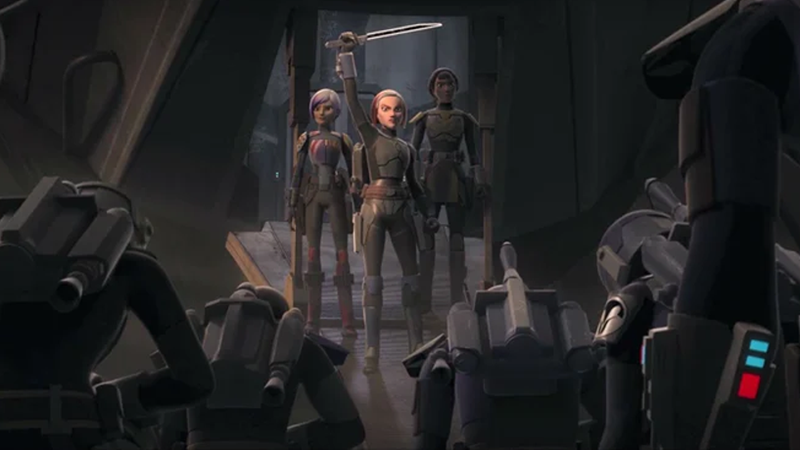
Kryze’s rule would last even shorter than her sister’s. Almost immediately after Maul’s arrest, the Clone War was brought to an abrupt end with the extermination of the Jedi and the reformation of the Republic into a Galactic Empire. Now-Imperial forces that had, in the weeks beforehand, helped wrest control of Mandalore from the Shadow Collective, remained on the world as an occupying force. Kryze was ousted by the Imperial-backed Gar Saxon and his clan, who became established as Mandalore’s Viceroy for the Empire.
Under Saxon, Mandalore became another world for the training and recruitment of non-Clone forces in the Imperial military. Utilizing a superweapon inadvertently created by a Mandalorian recruit at the Imperial Academy established on Mandalore—capable of targeting the beskar alloy in Mandalorian armor and electrocuting its wearer—Saxon and his personal guard of Mandalorian Supercommandos suppressed resistance to the regime for the best part of two decades, driving Kryze and her resistance underground.
Aided by members of local cell from the nascent Rebel Alliance, however, Kryze and her forces were able to mount a successful uprising against Saxon and the Empire. They rallied once again under the rule of the Darksaber, and for the first time since the outbreak of the civil war, Mandalore was united and at peace.
The Purge

Like all good things in Mandalore’s history however, peace wasn’t meant to last. In the waning years of the Galactic Civil War, the Empire responded to the loss of Mandalore with stunningly destructive retribution. In what became known after the Empire’s own downfall as the Great Purge, the Imperial Navy barraged the surface of Mandalore with bombing runs and gunship fire, destroying its dome cities and all but committing genocide. Amid the chaos, Moff Gideon secured the Darksaber for his own collection, and Bo-Katan, along with the remaining survivors of the assault, fled their ravaged homeworld.
The extermination of the Mandalorians pushed their remnants into hiding across the galaxy, scattering clans and coverts through the rim. Many turned to mercenary work. Many, tracing their lineage to the Martial Traditionalists of the civil war and its successor Death Watch, also re-embraced strict warrior codes and traditions as an attempt to keep some aspect of Mandalore’s now bombed-out history alive.
A New Hope?
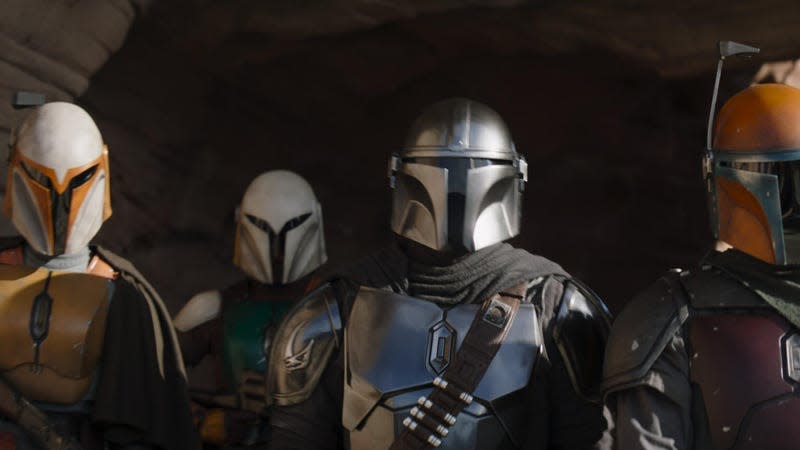
But change appears to be on the horizon once more as we head into The Mandalorian season three. Bo-Katan Kryze’s attempts to reclaim her regency have been pushed back by the emergence of a new wielder of the Darksaber—Din Djarin, a former foundling adopted by Death Watch and raised as a member of one of the hidden coverts that stayed true to “The Way,” a martial culture inspired by the Martial Traditionalists. Now having adopted a Force-sensitive child as his own ward, Djarin is attempting to return to the devastated Mandalore having been ousted by his former tribe, to atone for his perceived crimes against his culture.
Little remains of the Mandalorian people, and little of Mandalore itself—but as the inevitable showdown between Kryze and her supporters, and the lone wolf Djarin, Mandalore is in the precipice of change. And perhaps, in some ways, an extended period of peace not felt on the world for generations.
More from Gizmodo
Sign up for Gizmodo's Newsletter. For the latest news, Facebook, Twitter and Instagram.

